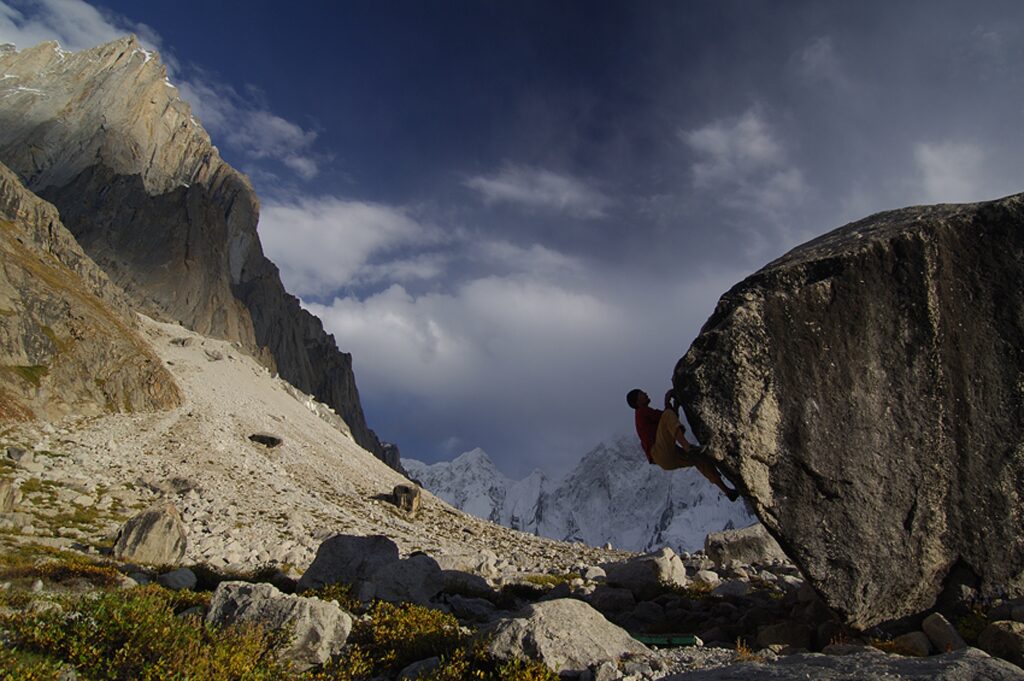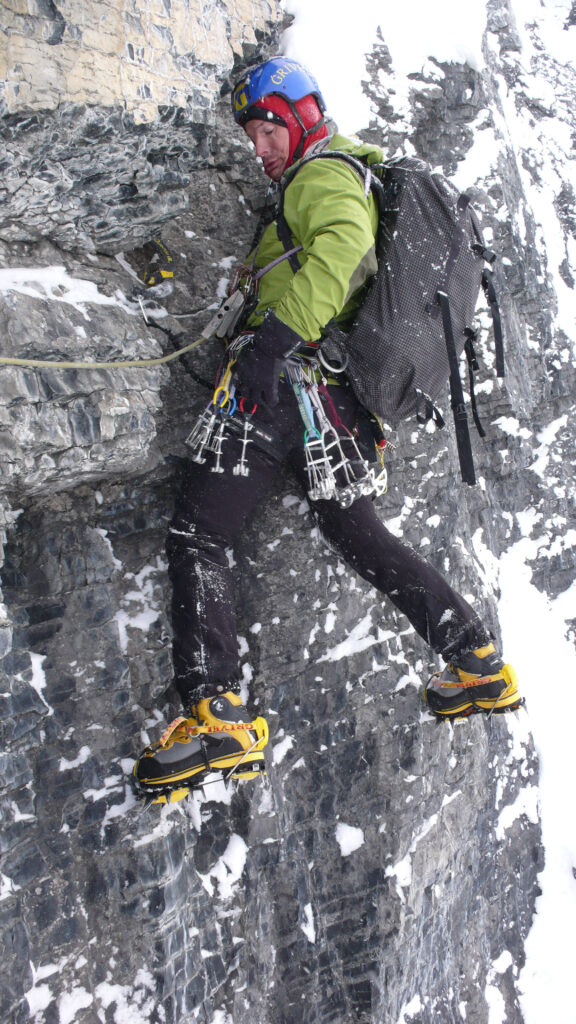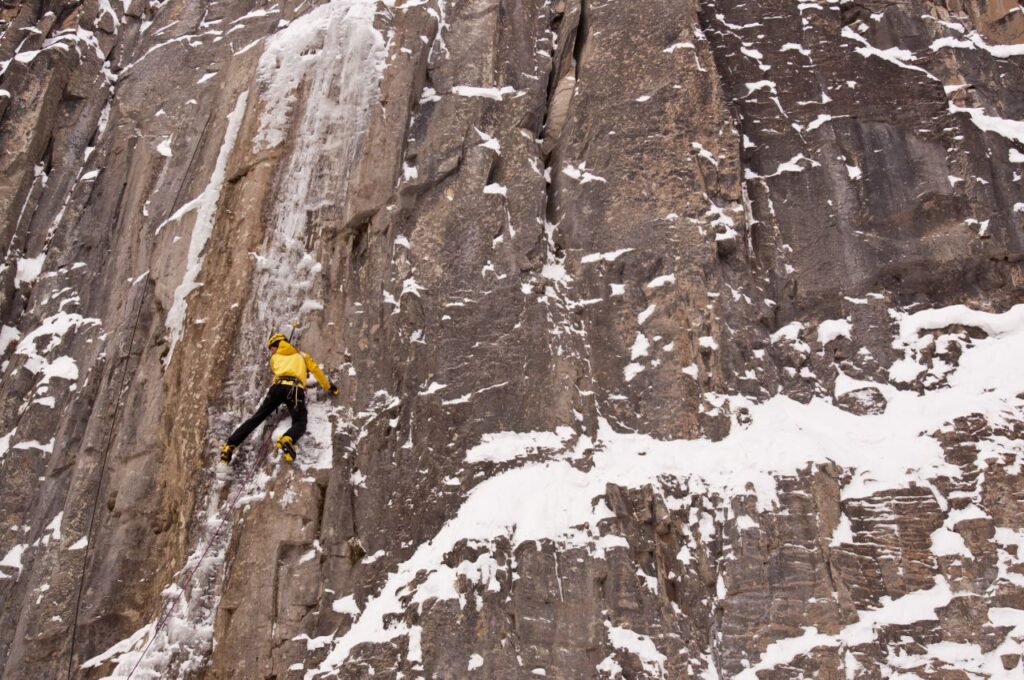We’ve all experienced fear. You are facing something that gets your heart racing, your palms sweating, and your brain goes into overdrive, figuring out what exactly to do to save yourself. Fear is a natural response to a perceived threat. That threat triggers the sympathetic nervous system, which releases a flood of hormones, including epinephrine and norepinephrine. These hormones put our body into a fight, flight or freeze mode. Evolutionarily, the fear response is meant to keep us alive.
However, the fear response of fight, flight, or freeze can lead to dangerous situations and pose an even greater threat to the athlete by responding rashly or inappropriately to a situation. It has also been found that fear can change our movement mechanics and lead to injury. But that doesn’t mean that all fear is negative. In fact, studies have shown the experience of fear in sports to be life-affirming and develop humility, courage, and a connectedness to nature.
In the mountains, fear is part of the athletic experience and can lead the athlete to a better understanding of themselves.

ANECDOTE ABOUT FEAR LEADING TO TRANSFORMATION OR TRANSCENDENCE
This transcendence and life affirmation is why it is not uncommon for individuals to seek out this fear sensation through risk-taking activities. Researchers conclude that this need for risk-taking is a combination of personality characteristics, socialization, and previous experience that drive a desire for the individual to seek this sensation. It comes as no surprise that most risk-takers display higher extroversion and impulsivity. Risk-seeking is also a deliberate way to create emotional arousal in the participant, something that they innately crave.
Although there has been a lot of talk of mountain athletes not experiencing fear and our brains functioning differently, this is not true. Mountain athletes, just like non-athletes, also experience fear and anxiety. However, what sets them apart is their approach to handling fear. Rather than letting it stop them, they embrace and utilize fear as a valuable part of their experience.
ANECDOTE OF EMBRACING FEAR
How we handle fear in our sport determines the outcome of our climb, ascent, etc. Maintaining control of the situation is one of the best ways to help mitigate fear. This means preparing and knowing what the weather, environment, and equipment will be before you head out. This will help maintain a sense of control and help with handling fear when approaching a difficult athletic endeavor. Rituals and positive self-talk were also shown to be some of the best ways for athletes to deal with fear.
Participating in rituals such as performing the same movements or packing gear before the event creates a sense of control and calming sensation. Positive self-talk mitigates the negativity that can overcome us when preparing for a risk-taking event.
For climbers specifically, focus is a key part of helping reduce fear, and focus is tied to self-confidence.
Lack of confidence can lead to choppy and uncoordinated movements, which lead to fatigue and lack of focus. That lack of focus breaks the climber from their flow and can lead to fear and anxiety.
Confidence is clearly important and with experience in the mountains, we inevitably gain confidence. Although this is overwhelmingly positive, confidence has some negative side effects that we need to be aware of. Over time, fear may be normalized and downplayed by the experienced climber (Bouchat and Brymer, 2019). This, obviously, can lead to lack of safety precautions and awareness of the surroundings being overlooked, which could lead to catastrophic events. It is important to use fear and not ignore it. This distinction needs to be very clear.
ANECDOTE ABOUT BEING CONFIDENT BUT SMART
As a climber and mountain athlete, it is important to recognize, respond, and prepare for fear, as it is an inevitable part of the experience.
As mountain athletes, we crave the rush and stimulation from risk-taking events. We love to push ourselves and feel the life-affirming feeling of conquering something we weren’t sure we would be able to or that not many before us have been able to do. That is part of why we do what we do, and with that, we must utilize our fear to be safe, make intelligent decisions, and use our ability to think clearly. At the end of the day, the mountain decides how our day goes, not us.
CONCLUSION
Fear plays a pivotal role in mountain sports, serving as a catalyst for personal growth, self-discovery, and transformation. While fear can pose risks and lead to negative outcomes if not managed properly, mountain athletes need to learn to navigate and embrace fear as an integral part of their sport. By maintaining control, utilizing rituals, practicing positive self-talk, and fostering confidence, athletes are able to harness the power of fear to push their limits, conquer challenges, and achieve life-affirming moments of triumph. So, let us not shy away from fear, but instead, let us use it wisely and consciously on our mountain adventures.

REFERENCES
Bouchat, P. & Brymer, E. (2019). BASE Jumping Fatalities Between 2007-2017: Main Causes of Fatal Events and Recommendations for Safety. Wilderness & Environmental Medicine, 30(4), 407-411.
Brymer, E.& Schweitzer, R. (2012). Extreme sports are good for your health: A phenomenological understanding of fear and anxiety in extreme sport. Journal of Health Psychology,18(4), 477-487.
Brymer, E. & Oades, L. (2009). Extreme sports: A positive transformation in courage and humility. Journal of Humanistic Psychology, 49(1), 114-126
Green. A, Gardner, D., & Legg, S. (2022). An Exploration of the Emotional Experience of BASE Jumping. Sport in Society, 25(2). 390-404.
Mackenzie, S. & Brymer, E. (2018). Conceptualising Adventurous Nature Sports: A Positive Psychology Perspective. Annals of Leisure Research.
Piepiora, P., Kwiecinski, A., & Migasjewicz, J. (2019). The Impact of the Level of Focus on a Change in the Level of Fear of Falling During Leading in Competition Climbing. Journal of Education, Health and Sport, 9(5), 516-533.

